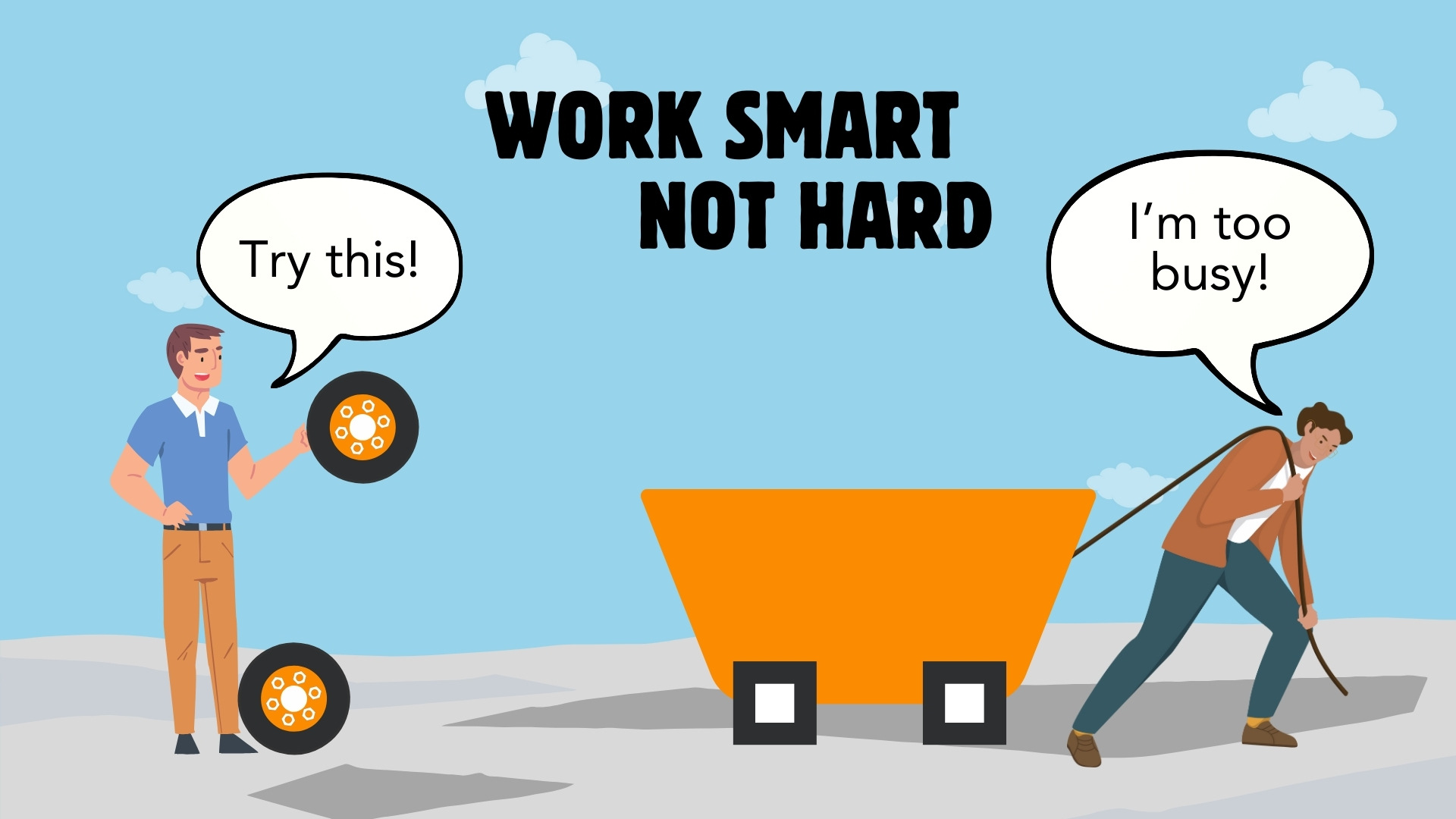How to leverage simplification reusability, and automations for business growth
The goal is simple, achieve more with less
“Workaholics aren’t heroes. They don’t save the day, they just use it up.
The real hero is home because they figured out a faster way.”
– Jason Fried, American entrepreneur
In times of disruption, a winning strategy can never be to work harder simply because human effort through manual work can never compete with automations. However, many leaders and employees work hard barely ever getting home in time to have dinner with their family.
No matter how dedicated or skilled employees are, they have physical and cognitive limits, which machines operate tirelessly, consistently, and without error (if programmed right). When implemented correctly, automation not only increases efficiency but also ensures high-quality delivery around the clock something that manual work can never achieve. Organizations that rely solely on human effort risk inefficiencies, inconsistencies, and an inability to scale, while those that embrace smart work gain a sustainable competitive advantage. In this article we will look at ways we as leaders can help our organizations work smarter and it all starts with our ability to simplify instead of “complexify”.
Simplification: the power of less
Complexity kills efficiency. In the agile community there is a saying that:
“Complexity is evil”.
As organizations grow, they often accumulate unnecessary processes, systems, and bureaucracy that slow them down. Leaders’ responsibility is to remove complexity.
“Complexity is your enemy. Any fool can make something complicated.
It is hard to make something simple.”
Richard Branson, British business magnate
Why It Matters
- Simplified processes reduce friction, lower operational costs, and speed up decision-making.
- Employees waste less time on redundant work, increasing productivity and morale.
If we as leaders allow complexity, we also allow waste.
Case study
For instance, some financial institutions have reviewed their end-to-end workflows and identified non-value-adding steps that could be consolidated or eliminated. This simplification, (not just automation) has been critical to reducing processing times and operational costs. (Source: App0)
According to a report by App0, a US-based mortgage lending company witnessed a threefold increase in loan origination volume without incurring additional costs by automating 85% of their standard loan setup tasks. (Source: App0)
Additionally, a report by McKinsey & Company highlighted that the average loan origination process takes 30 days or more to complete, and lenders lose an estimated $10 billion annually due to fraud and errors. The report also found that only 20% of lenders have fully digitized their loan origination processes. (Source: App0)
These examples demonstrate the benefits of process simplification, through reducing complexity, removing unnecessary steps and where appropriate, combining it with automation, to optimize loan origination.
AI and automation: let machines do the heavy lifting
Repetitive, time-consuming tasks are best handled by technology, not people. Automation and AI enable businesses to scale efficiently without increasing headcount.
Why It Matters
- AI and automation free up human talent for higher-value goals like strategy and innovation.
- They ensure consistency, reduce errors, and operate 24/7.
- Businesses can handle increased workloads without proportionally increasing costs.
Example
Amarra, a New Jersey-based distributor of special-occasion gowns, implemented AI chatbots that now handle 70% of customer inquiries. This automation has allowed human agents to focus on more complex issues, leading to increased efficiency in customer service operations. (Source: Businessinsider.com)
Notice that automations and AI don’t mean removing humans all together but rather focus them on critical work like better customer focus such as innovation and human interaction.
This also requires other skills. Check out our article: Mind the gap: Why the skills you have today won’t win tomorrow.
As leaders we must understand that;
“AI won’t replace managers. But managers who use AI will replace those who don’t.”
– Paul Daugherty, CTO of Accenture
Reusability: stop reinventing the wheel
Reusability in business means optimizing what already exists rather than constantly starting from scratch. This can be applied in many areas such as processes, technology, and decision-making strategies etc.
Why It Matters
- Saves time and resources by leveraging existing assets.
- Reduces development and operational costs.
- Free up time for impact work
- Ensures high quality, consistency and reliability.
Example: Single Source reusability
Single Source Reuse refers to the practice of creating and maintaining content in a single, centralized location and reusing it across multiple outputs, formats, or channels. Instead of duplicating content, references (such as links or variables) are used to ensure consistency, reduce redundancy, and improve efficiency.
Duplication is not smart. But what are links? In the context of single source reuse, links (and variables) are essential tools that help reference content without duplicating it. They allow businesses to maintain a single source of truth, ensuring content remains consistent across different platforms and documents.
Instead of copying and pasting text or media, links ensure that any updates made to the original source automatically reflect in all linked instances whereas when copy paste is used updates need to be made in multiple places which take time, drive cost and have a high risk of manual mistakes meaning updates may differ which create issues of different versions being active at the same time multiplying the issue.
Case Study
A case study involving a data warehouse project highlights the benefits of single-sourcing. The technical writer recognized that the content could be utilized across various documents and formats. By implementing a single-source authoring tool, they created content once and published it in multiple formats, including online help and printed manuals. This approach led to more efficient content creation, reduced errors, and streamlined the review process. (Source: Madworld)
Example: Have a clear Make-or-buy strategy
Another example of reusability is using what others have already developed, learned etc. Instead of developing everything in-house, we can buy proven solutions when it’s more cost-effective.
Having a clear make-or-buy strategy means establishing a well-defined decision-making framework for determining whether an organization should internally produce (make) a solution, service, or component or outsource (buy) it from an external supplier. This strategy is crucial for optimizing costs, efficiency, quality, speed and competitive advantage.
Make-or-buy should be guided by strategic intent, not capacity relief.
Case study
A case study from the nail polish industry examines the decision to produce metallic nail paints in-house or outsource production. The company analyzed factors such as cost implications, strategic alignment, and operational efficiency. The analysis revealed that outsourcing production could be more cost-effective and allow the company to focus on its core competencies, leading to better resource allocation and profitability.(Source: Medium)
Having a clear make or buy strategy underscores the importance of strategic decision-making in content management and production processes to enhance efficiency and maintain consistency. Read our case study “How Ica uses make or buy to ensure smart reusability” to learn more.
Using frameworks, systems, tools etc. others have spent years refining is smarter than building it from scratch ourselves. It’s faster, cheaper and often bring higher quality than we could ever produce ourselves. If it’s not make it! If it is buy it!
Do you have this kind of reusability in your organization?
Leaders must make sure Make or Buy decisions can be made in production not only at the top.
Having clarity on what we make and what we buy must be the top executive responsibility or we risk running an ineffective and inefficient “shop”.
Key take aways
- Simplify everything. Complexity slows down business, trim unnecessary steps and processes.
- Automate and leverage AI. Machines handle routine tasks better, freeing up employees for high-impact work.
- Reuse don’t reinvent. Optimize and repurpose existing solutions to save time and money.
- Make smarter investments. Sometimes buying an existing solution is better than building from scratch.
By embracing smart work, organizations can increase efficiency, reduce costs, and gain a competitive edge. Smart leaders don’t just work hard; they work smart and lead smart work.
Do you want to learn how to lead your organization to work smarter?


